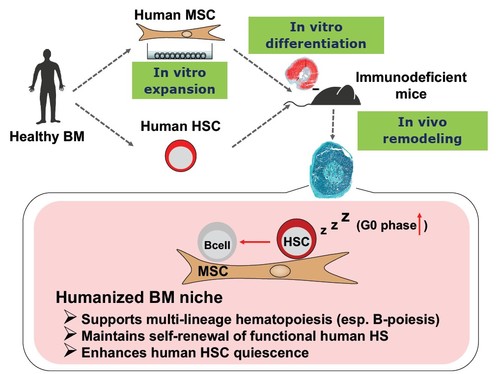- HOME
- News & Events
- Publications
- 【Publications】Engineered humanized bone organs maintain human hematopoiesis in vivo
Publications
【Publications】Engineered humanized bone organs maintain human hematopoiesis in vivo
February 21 2018
Hitoshi Takizawa
Paper information
Fritsch K, Pigeot S, Feng X, Bourgine PE, Schroeder T, Martin I, Manz MG, Takizawa H
Engineered humanized bone organs maintain human hematopoiesis in vivo
Exp Hematol. 2018 Feb 9. pii: S0301-472X(18)30038-9. doi: 10.1016/j.exphem.2018.01.004.
[Epub ahead of print]
DOI: https://doi.org/10.1016/j.exphem.2018.01.004
PMID:29410245
Highlights
- Human mesenchymal stromal cell-derived ossicles can support multilineage human hematopoiesis
- Functional human hematopoietic stem and progenitor cells are maintained in the human ossicle
- Human hematopoietic stem cells cycle less in human ossicles than in mouse bone marrow.
Abstract
Hematopoietic stem cells (HSCs) are maintained in a specialized bone marrow (BM) environment, the so-called HSC niche, that provides pivotal factors for their maintenance. Although the cellular and molecular components of the mouse BM HSC niche have been extensively studied using genetically modified animals, relatively little is known about the counterpart human BM niche components. We previously illustrated, with a developmental tissue engineering approach, that human adult BM-derived mesenchymal stromal cells (MSCs) can develop into human bone organs (so-called ossicles) through endochondral ossification in vivo and that these human ossicles are able to maintain functional mouse HSCs. We here report that human ossicles in immunodeficient mice maintain human immature and mature hematopoiesis in vivo. Moreover, a higher percentage of human stem and progenitor cells are kept in quiescence in human ossicles as compared with mouse BM. These findings indicate that the human MSC-derived ossicles function as a hematopoietic niche and may potentially serve as a re-engineerable platform to study normal and diseased human hematopoiesis in a physiologically optimized environment.

